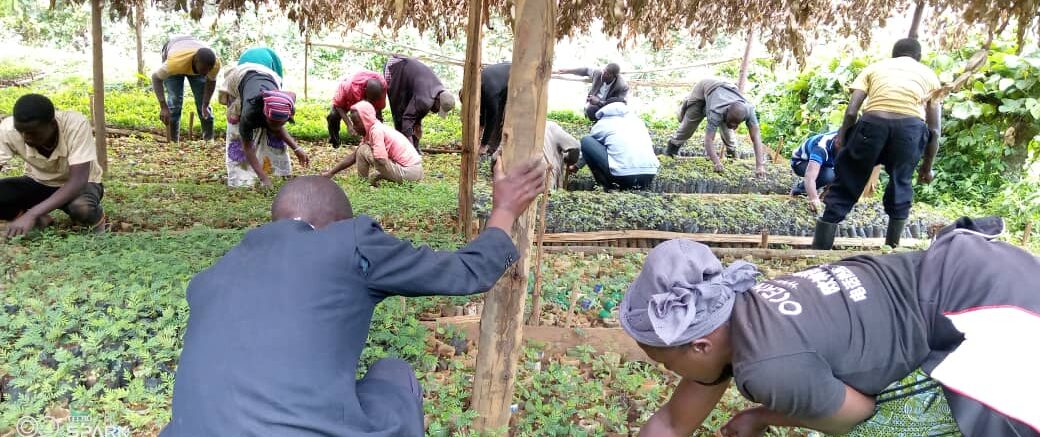Approach 2: Educating Farmers and Community Members in Tree Planting Techniques
Achieving the goal of educating farmers and community members, setting tree planting targets, and providing free seedlings to achieve a minimum tree cover of 30% requires a comprehensive and participatory approach. Here’s a step-by-step guide on how NCCDO plans to effectively implement this initiative:
1. Community Outreach and Education:
- Workshops and Training Programs:
Conduct workshops and training programs to educate farmers and community members on the importance of tree cover, agroforestry practices, and the benefits of achieving a 30% tree cover.
- Interactive Learning Sessions:
Organize interactive sessions that demonstrate practical aspects of tree planting, care, and maintenance. This hands-on approach enhances understanding and encourages active participation.
- Informational Materials:
Develop and distribute informational materials, such as pamphlets, posters, and videos, to reinforce key messages and serve as ongoing references for community members.
2. Setting Targets:
- Community Engagement:
Collaborate with community members to set realistic and achievable targets for tree planting. This could be done through community meetings, surveys, and discussions to ensure that the goals align with the community’s capacity and needs.
- Tailored Plans for Farms:
Work with individual farmers to develop tailored tree planting plans based on the size and characteristics of their farms. This includes selecting appropriate tree species and determining optimal planting locations.
3. Free Seedling Distribution:
- Establish Community Nurseries:
Set up community nurseries or collaborate with existing local nurseries to cultivate a variety of tree species suitable for the region’s agroforestry practices.
- Seedling Variety:
Ensure a diverse range of tree species are available, including fruit trees, nitrogen-fixing plants, and those with economic value. This caters to the specific needs and preferences of the community.
- Distribution Events:
Organize community events or distribution days where free seedlings are provided to all members. This could be combined with educational sessions to reinforce the importance of proper planting and care.
4. Community Involvement and Ownership:
- Formation of Tree Planting Groups:
Encourage the formation of tree planting groups within the community. These groups foster a sense of collective responsibility and enable shared knowledge and experiences.
- Community Leadership:
Identify and empower community leaders or champions who can inspire and motivate others. Their leadership can play a crucial role in ensuring the success of the initiative.
5. Monitoring and Support:
- Regular Monitoring:
Implement a system for regular monitoring of tree planting progress. This includes tracking the survival and growth of planted trees, identifying challenges, and celebrating successes.
- Providing Technical Support:
Offer ongoing technical support to address challenges and provide guidance on proper tree care. This may involve organizing follow-up workshops, farm visits, or establishing a helpline for community members.
6. Celebrating Milestones:
- Recognition Events:
Organize events to celebrate milestones and achievements in tree planting. Recognize individuals, families, or groups that exceed planting targets, fostering a sense of pride and accomplishment.
- Community-wide Celebrations:
Plan community-wide celebrations to create a positive and festive atmosphere. These events not only acknowledge the efforts of community members but also reinforce the importance of the collective impact.
7. Feedback and Adaptation:
- Community Feedback Sessions:
Establish regular feedback sessions to gather input from community members. This can help in assessing the effectiveness of the initiative, addressing concerns, and making necessary adjustments.
- Adaptive Management:
Embrace an adaptive management approach, adjusting strategies based on feedback, changing environmental conditions, or emerging challenges. This ensures the initiative remains relevant and responsive to the community’s needs.
8. Documentation and Communication:
- Case Studies and Success Stories:
Document and share case studies and success stories within the community. This creates positive narratives, inspires others, and reinforces the value of achieving a 30% tree cover.
- Regular Communication Channels:
Establish regular communication channels, such as newsletters, community meetings, or social media groups, to keep community members informed about the progress of the initiative and upcoming activities.
